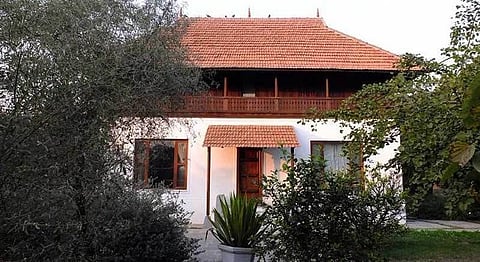
- HOMEGROWN WORLD
- #HGCREATORS
- #HGEXPLORE
- #HGVOICES
- #HGSHOP
- CAREERS
- ABOUT US
- CONTACT US

Little box houses carefully stacked on top of each other create the skyscrapers that adorn our concrete jungle’s skyline. There’s hardly any space to be creative with architecture, nor do we have the time, money or passion, as such, to carry on architectural traditions that have struggled to survive for so long in our country. Pradeep Sachdeva, a Delhi-based architect, understands the value and craftsmanship of traditional architecture, and when he heard about his friend’s deteriorating wooden house in Kerala, he knew he had to save it.
Meda, as it is called, is a 300-year-old wooden house in Mepral, Kerala, and has been in the Oommen family for generations. While most traditional houses in Kerala were a single storey structure, Meda was unique for having two floors, yet has all the characteristics of a traditional Keralan home. Over the years, members of the family moved away and abroad, Meda was left empty. George Oommen inherited the property and would visit the house every year from the US, where he was based. He saw Meda’s deterioration, and when termites began to eat away at his family’s legacy he knew this beautiful tharavad would not survive as it was.
Oommen worried for the house’s future in this condition, but he wasn’t going to just sell it off. Meda was something he inherited, it held a special place in his family’s collective memory and history, and it didn’t belong to him alone. Weeding through his options, he soon realised that buyers didn’t want the house. It was the property it stood on that they were interested in – Meda would be torn down, it’s pieces sold off as artefacts and timber.
This is where Sachdeva stepped in. A friend of Oommen, he offered to buy and restore without even seeing it. “I bought it pretty much unseen because one knew of these Kerala houses, one had seen them, and they are so sensationally beautiful. I think it’s the quality of space, quality of planning. It’s the craft of putting it together and there’s a whole science to it which they did follow. It’s a traditional form of Vastu Shastra which is really a science of building, rather than what we make out of it today as a very esoteric mumbo jumbo type thing. It’s like a course in studying architecture – that’s the Vastu Shastra as practised by people here,” said Sachdeva in A House From Kerala, a documentary film by Sudhesh Unniraman that follows the deconstruction and restoration of Meda. When Sachdeva planned to shift the house to Delhi he had many challenges to face, other than the 3,000-kilometre distance. How do you relocate an entire house?
Kerala had a strong tradition of wood architecture, mastered by a local community of carpenters. Meda’s creation too followed this systematic and sophisticated method of wood joinery – many parts of it had even been put together without any nails. Sachdeva’s first task became finding someone who understood the nuances of this form. Thankfully, he found Narayan Achari, and his team of carpenters, who carefully took apart Meda piece by piece, numbered and logged its components over days. They assessed the wear and tear of the wood and tiles of the house, having aged over the years after braving storms, harsh sunlight and floods. Soon, Meda’s was ready to be transported.
As it was taken apart, the 2,000-square-foot house was put back together by Narayan and his team on Sachdeva’s own farm in Sadhrana village, Gurugram. A new first floor was constructed with plaster and brick, and Meda did get a few upgrades, other than the replaced broken tiles and rotting wood. “We tried to conserve nearly everything as it was, although we did add electricity and plumbing,” Sachdeva told The New York Times. An iron spiral staircase replaced the previous wooden one, although parts of the original were repurposed as parts of shelves and a dining table.
“I feel I saved a piece of my family,” Oommen told The New York Times. Meda gained a new lease at life, not only that but its restoration and conservation helped preserve a traditional form of Indian architecture as well as the knowledge and skills of the practising carpenter community.
If you enjoyed this article we suggest you read:
